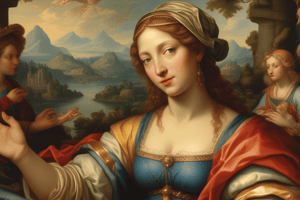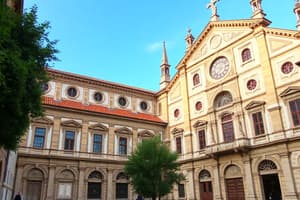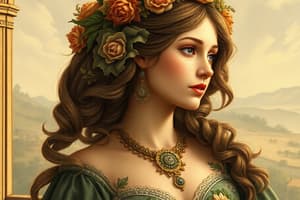Podcast
Questions and Answers
What is the Italian term for the Renaissance, meaning 'rebirth'?
What is the Italian term for the Renaissance, meaning 'rebirth'?
- Renaissancea
- Rinascenza
- Renaissance
- Rinascimento (correct)
Which century is considered the Early Renaissance period in Italy?
Which century is considered the Early Renaissance period in Italy?
- 17th century
- 15th century (correct)
- 16th century
- 14th century
What architectural characteristic is most emphasized in the Early Renaissance architecture?
What architectural characteristic is most emphasized in the Early Renaissance architecture?
- Imitative classical detail
- Complex ornamentation
- Solemnity in structure
- Free use of classical details (correct)
During which period did the characteristics of High Renaissance architecture primarily emerge?
During which period did the characteristics of High Renaissance architecture primarily emerge?
Which term refers to the Italian Renaissance architecture of the 16th century?
Which term refers to the Italian Renaissance architecture of the 16th century?
Humanist ideas during the Renaissance primarily influenced which aspect of architecture?
Humanist ideas during the Renaissance primarily influenced which aspect of architecture?
What architectural feature is used to support Brunelleschi's dome?
What architectural feature is used to support Brunelleschi's dome?
Which of the following is not a characteristic of Renaissance architecture?
Which of the following is not a characteristic of Renaissance architecture?
What is the primary purpose of the term 'Late Renaissance'?
What is the primary purpose of the term 'Late Renaissance'?
What is the primary purpose of the herringbone-pattern brickwork used in the dome?
What is the primary purpose of the herringbone-pattern brickwork used in the dome?
What was a significant challenge in constructing the dome of the Florentine Duomo?
What was a significant challenge in constructing the dome of the Florentine Duomo?
Which Renaissance architect was influenced by Brunelleschi's work?
Which Renaissance architect was influenced by Brunelleschi's work?
What is the height of the Florentine Duomo's dome, including the lantern?
What is the height of the Florentine Duomo's dome, including the lantern?
How did Brunelleschi's study of ancient buildings contribute to his architectural designs?
How did Brunelleschi's study of ancient buildings contribute to his architectural designs?
What unique design element does Alberti incorporate into the façade of Sant Andrea in Mantua?
What unique design element does Alberti incorporate into the façade of Sant Andrea in Mantua?
Which characteristic reflects the influence of Gothic architecture in the dome's design?
Which characteristic reflects the influence of Gothic architecture in the dome's design?
What feature distinguishes the first story in the graded sequence of architectural styles described?
What feature distinguishes the first story in the graded sequence of architectural styles described?
What is the purpose of the smaller pilasters in the design?
What is the purpose of the smaller pilasters in the design?
Which architectural element is described as resting on Brunelleschian classicizing columns?
Which architectural element is described as resting on Brunelleschian classicizing columns?
What term refers to the superstructure that allows light and air into a dome or roof?
What term refers to the superstructure that allows light and air into a dome or roof?
What does the term 'colossal order' refer to in the context of the larger pilasters?
What does the term 'colossal order' refer to in the context of the larger pilasters?
In which architectural style are double-lancet windows commonly found?
In which architectural style are double-lancet windows commonly found?
What architectural element did Alberti inscribe within a square to unify the façade?
What architectural element did Alberti inscribe within a square to unify the façade?
What is the likely function of a whispering gallery?
What is the likely function of a whispering gallery?
Which architectural feature does not appear in the nave's interior according to Alberti's design?
Which architectural feature does not appear in the nave's interior according to Alberti's design?
What was a significant goal of fifteenth-century humanists as reflected in Alberti's work?
What was a significant goal of fifteenth-century humanists as reflected in Alberti's work?
Which feature is associated with the belvedere in architecture?
Which feature is associated with the belvedere in architecture?
What characterizes the architectural style of Michelozzo's Palazzo Medici-Riccardi?
What characterizes the architectural style of Michelozzo's Palazzo Medici-Riccardi?
What was a significant change in the status of artists by the end of the fifteenth century in Italy?
What was a significant change in the status of artists by the end of the fifteenth century in Italy?
What architectural feature is intended to make a structure appear lighter on top?
What architectural feature is intended to make a structure appear lighter on top?
Which notable modification was made to the Palazzo Medici-Riccadi in the early 16th century?
Which notable modification was made to the Palazzo Medici-Riccadi in the early 16th century?
Which of the following best describes the political landscape of Italy during the Renaissance?
Which of the following best describes the political landscape of Italy during the Renaissance?
What is the primary purpose of a cupola in architecture?
What is the primary purpose of a cupola in architecture?
How did Michelozzo adapt the rustication found in the Palazzo della Signoria?
How did Michelozzo adapt the rustication found in the Palazzo della Signoria?
What architectural element was significant about Brunelleschi's design for the dome of the Florence Cathedral?
What architectural element was significant about Brunelleschi's design for the dome of the Florence Cathedral?
Which city is often considered the birthplace of the Renaissance?
Which city is often considered the birthplace of the Renaissance?
How did medieval institutions influence architectural patronage in the Renaissance?
How did medieval institutions influence architectural patronage in the Renaissance?
What was one architectural strategy Brunelleschi used to construct the dome of Florence Cathedral?
What was one architectural strategy Brunelleschi used to construct the dome of Florence Cathedral?
Which of the following regions in Italy was a monarchy during the Renaissance period?
Which of the following regions in Italy was a monarchy during the Renaissance period?
What was a characteristic of the buildings commissioned by medieval institutions during the Renaissance?
What was a characteristic of the buildings commissioned by medieval institutions during the Renaissance?
Flashcards
Renaissance
Renaissance
A period in European history (14th-17th centuries) marked by a renewed interest in classical art, literature, and learning, seen as a rebirth of knowledge.
Italian Renaissance Architecture
Italian Renaissance Architecture
A distinctive style of architecture that emerged in Italy during the 15th and 16th centuries, emphasizing symmetry, mathematical precision, and simplicity.
Early Renaissance
Early Renaissance
The first stage of the Italian Renaissance (15th century), characterized by innovative and creative use of classical architectural elements.
Quattrocento Architecture
Quattrocento Architecture
Signup and view all the flashcards
High Renaissance
High Renaissance
Signup and view all the flashcards
Cinquecento Architecture
Cinquecento Architecture
Signup and view all the flashcards
Humanist Influence on Renaissance Architecture
Humanist Influence on Renaissance Architecture
Signup and view all the flashcards
Renaissance artists and ancient works
Renaissance artists and ancient works
Signup and view all the flashcards
Patronage in the Renaissance
Patronage in the Renaissance
Signup and view all the flashcards
City-states in Renaissance Italy
City-states in Renaissance Italy
Signup and view all the flashcards
Dome of Florence Cathedral
Dome of Florence Cathedral
Signup and view all the flashcards
The dual shells of Brunelleschi's dome
The dual shells of Brunelleschi's dome
Signup and view all the flashcards
The Cathedral of Florence
The Cathedral of Florence
Signup and view all the flashcards
The dome of the Cathedral of Florence
The dome of the Cathedral of Florence
Signup and view all the flashcards
Florence Cathedral Dome: Double Shell Construction
Florence Cathedral Dome: Double Shell Construction
Signup and view all the flashcards
Who designed the Florence Cathedral Dome?
Who designed the Florence Cathedral Dome?
Signup and view all the flashcards
Brunelleschi's Influence from Ancient Architecture
Brunelleschi's Influence from Ancient Architecture
Signup and view all the flashcards
Herringbone Brickwork in the Florence Cathedral Dome
Herringbone Brickwork in the Florence Cathedral Dome
Signup and view all the flashcards
Sant'Andrea in Mantua: Classical and Basilica Fusion
Sant'Andrea in Mantua: Classical and Basilica Fusion
Signup and view all the flashcards
Florence Cathedral: Dimensions and Scale
Florence Cathedral: Dimensions and Scale
Signup and view all the flashcards
Who designed Sant'Andrea in Mantua?
Who designed Sant'Andrea in Mantua?
Signup and view all the flashcards
Sant'Andrea Facade: Triumphal Arch and Temple Fusion
Sant'Andrea Facade: Triumphal Arch and Temple Fusion
Signup and view all the flashcards
Rustication
Rustication
Signup and view all the flashcards
Lantern
Lantern
Signup and view all the flashcards
Cupola
Cupola
Signup and view all the flashcards
Tambour
Tambour
Signup and view all the flashcards
Interdome
Interdome
Signup and view all the flashcards
Lucarne
Lucarne
Signup and view all the flashcards
Whispering Gallery
Whispering Gallery
Signup and view all the flashcards
Belfry
Belfry
Signup and view all the flashcards
Square Form in Sant Andrea Facade
Square Form in Sant Andrea Facade
Signup and view all the flashcards
Colossal Order
Colossal Order
Signup and view all the flashcards
Unified Architecture
Unified Architecture
Signup and view all the flashcards
Triumphal Arch Motif
Triumphal Arch Motif
Signup and view all the flashcards
Synthesis of Ancient and Christian Forms
Synthesis of Ancient and Christian Forms
Signup and view all the flashcards
Classical Forms in Architecture
Classical Forms in Architecture
Signup and view all the flashcards
Renaissance Palaces
Renaissance Palaces
Signup and view all the flashcards
Study Notes
Renaissance Architecture in 13th and 14th Century Italy
- Renaissance, meaning "rebirth," refers to a period of revival in classical learning, literature, and art, originating in Italy during the 14th century and extending into the 17th century.
- Italian Renaissance architecture, emerging in the 15th and 16th centuries, prioritized symmetry, precise mathematical relationships between parts, and a simple, balanced aesthetic.
- Modern historians categorize Italian Renaissance architecture into stages: Early Renaissance (15th century), High Renaissance (late 15th and early 16th centuries), and Late Renaissance (16th century).
Humanist Influence
- Humanist ideas influenced Renaissance artists and patrons, encouraging the study of ancient texts and works, aiming to recreate or understand them.
- Architects sought to imitate architectural details and principles from ancient works.
- Religious institutions, guilds, and secular patrons commissioned art and architecture; artists gained recognition and status throughout the century.
Political Conditions in Italy
- Italy lacked a unified political structure during this period, with competing city-states and regional entities often engaging in conflicts.
- Political entities were varied, with some areas ruled by monarchs, others by princes and despots, and some by republics.
The Early Renaissance in Fifteenth-Century Italy, Florence & Brunelleschi's Dome
- Filippo Brunelleschi, a prominent figure, demonstrated innovative design solutions.
- His study of ancient Roman ruins informed his architectural designs.
- The Florence Cathedral dome, a complex engineering feat, exemplifies his mastery. Key dimensions of the project include a vast dome, with a building area of 8,300 m², a length of 153 meters, a width of 38 meters and a high height of arches, at 23 meters and dome's height of 114.5 meters
- Brunelleschi employed innovative techniques to accomplish this architectural marvel. He developed innovative techniques like two separate dome shells, ribbed construction, to effectively build the dome.
Sant'Andrea in Mantua – Leon Battista Alberti
- Alberti sought to fuse classical temple forms with typical basilica churches.
- Using classic details and layouts for his church design, such as large, pilasters, triumphal arches, and colossal orders.
- He adjusted the style of previous structures to fit the Christian needs.
Palace Architecture
- Palace design mirrored the growing wealth and status of important families.
- Builders aimed to reflect the owner's refined taste and family's strength using classical forms.
- The Palazzo Medici-Riccardi, a prominent example, employs elements like rustication, and a central courtyard, showcasing the era's architectural sophistication, and grandeur.
Technical Aspects of Early Renaissance Architecture
- Rustication, a type of ashlar masonry using contrast between dressed stones.
- Courtyards featuring ornate carvings and windows.
- The use of classical elements like columns, friezes, and arches.
Studying That Suits You
Use AI to generate personalized quizzes and flashcards to suit your learning preferences.




